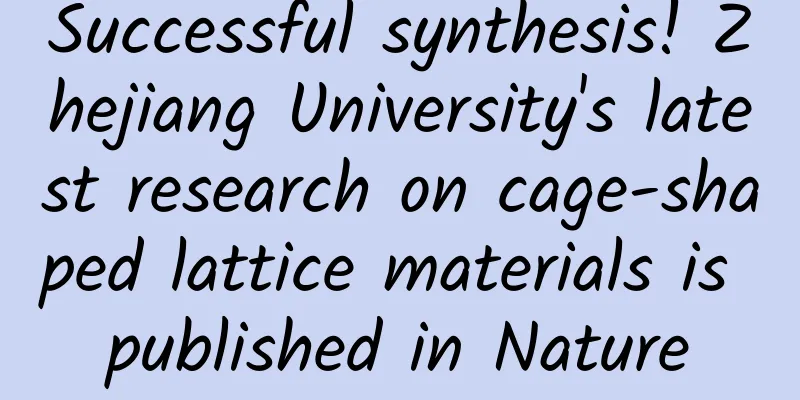Successful synthesis! Zhejiang University's latest research on cage-shaped lattice materials is published in Nature

|
About 40 years ago, unconventional superconductors opened a new chapter in condensed matter physics; about 10 years ago, the cage structure model triggered a grand "cage quantum party". Today, the two have created a shining "spark" in the laboratory of Zhejiang University: The research group of Cao Guanghan from the School of Physics at Zhejiang University, together with the research groups of Cheng Jinguang and Zhou Rui from the Institute of Physics of the Chinese Academy of Sciences, have made an important breakthrough in the research of kagome lattice materials . They have successfully synthesized a new type of chromium-based kagome lattice antiferromagnet and achieved superconductivity at the magnetic edge through pressure regulation, which is very similar to unconventional superconductors . This research provides a new research platform for further exploring novel quantum states in kagome lattices and understanding the mechanism of unconventional superconductivity. The relevant results were published in the journal Nature* under the title "Superconductivity under pressure in a chromium-based kagome metal". Kagome lattice ——A magical "cradle" There is a common pattern in traditional bamboo weaving products, where regular triangles with common vertices are connected to form a "cage-mesh" pattern. This structure has been favored by scientists in recent years. Theory predicts that materials with atomic arrangement having a "cage-mesh" lattice structure may produce special electronic behavior and magnetic properties. Therefore, they call materials with this crystal structure cage-mesh materials. Image: Cage pattern in bamboo basket Over the past decade, cage-structured materials have been like a magical "cradle" that has bred many novel quantum states and physical effects. In particular, the discovery of vanadium-based cage-structured lattice materials in 2019 has triggered a new round of research boom in the field of condensed matter physics. This type of material exhibits a dazzling array of novel states and phenomena, such as superconductivity, "unconventional" charge density waves, "f-anomaly" Hall effect, pairing density waves, electron nematic order, and time reversal symmetry breaking. "We have always wanted to realize unconventional superconductivity in the emerging system of vanadium." Professor Cao Guanghan said that at present, there is a mature theory on the formation mechanism of conventional superconductivity; but for unconventional superconductors such as high-temperature superconductors, people lack a consensus on their mechanism. The existing unconventional superconductors are not rich enough, and the discovery of unconventional superconductors is of great value in both basic science and applied research. "The source of superconductivity of vanadium-based vanadium materials can still be explained by conventional superconductivity mechanisms." Cao Guanghan said that according to experience, unconventional superconductivity often appears at the edge of magnetism, so the introduction of magnetism has a positive effect on the realization of unconventional superconductivity. However, the magnetism cannot be too strong, otherwise the superconductivity will be completely suppressed by magnetism. "Considering that chromium elements often have magnetism in compounds, we believe that new compounds completely replaced by chromium may have localized magnetic moments, coupled with the geometric frustration characteristics of the cage lattice, it is possible to produce unconventional superconductivity by suppressing magnetism." Figure: Crystal photo and crystal structure of chromium-based cage material After a long period of experimental exploration, the research team successfully grew chromium-based single crystals by significantly changing the ratio of the co-solvent. In the material preparation laboratory, Dr. Liu Yi was struggling to find chromium-based single crystals with a cage structure. "Usually, 5 grams of raw materials can produce less than 5 mg of sample." Liu Yi said, "Because the target product is a metastable phase, the actual grown products are mostly thermodynamically stable phases, so the yield is only about one thousandth. The size of the single crystal is basically within 0.5 mm, which is equivalent to the thickness of a pen tip." Correlation, magnetism, quantum criticality and superconductivity Figure: Schematic diagram of magnetism, quantum criticality and superconductivity in two-dimensional kagome lattice (a); comparison of the electronic structures of chromium-based and vanadium-based "135" materials (b). In the "one in a thousand" chromium-based cage structure lattice, three chromium atoms form an equilateral triangle, becoming a "mesh". Experimenters conducted measurements of resistance, magnetic susceptibility, specific heat, and nuclear magnetic resonance on the "one in a thousand" single crystal and found that the new material is different from the vanadium-based cage system. Liu Yi introduced that the single crystal is a strongly correlated "bad metal" with a unique spin density wave. First-principles calculations show that the Fermi energy is very close to the flat band caused by quantum interference destructive, which may be the root cause of the strong correlation effect. The most exciting thing is the tested superconductivity. In the comprehensive extreme conditions laboratory located in Beijing Huairou Science City, a major national scientific and technological infrastructure, researchers applied pressure, and the magnetic order or density wave order was suppressed until superconductivity appeared. It is reported that most unconventional superconducting systems have a universal electronic phase diagram associated with magnetism. By adjusting the control parameters (chemical doping, pressure, electric field, etc.), the magnetic order can be gradually suppressed, and unconventional superconductivity will appear. "Our work reveals that the chromium-based cage lattice system also has an electronic phase diagram similar to that of typical unconventional superconductors." Cao Guanghan said. It is worth mentioning that the highest superconducting transition temperature of the system (6.4 K) appears near the pressure point (also known as the quantum critical point, QCP) where the magnetic order disappears, and the upper critical magnetic field exceeds the Pauli paramagnetic limit. At the same time, the high-temperature normal state shows non-Fermi liquid (or strange metal) behavior. Photo: Professor Cao Guanghan (right) and Dr. Liu Yi discussing in the laboratory Cao Guanghan said that it is a new type of cage material system with characteristics such as flat band and geometric frustration related to the cage lattice. Its pressure-induced superconductivity shows many commonalities of unconventional superconductors. In-depth research on it will help solve the problem of unconventional superconductivity mechanism. Professor Qimiao Si of Rice University and his collaborators commented on this work in their paper, saying that the discovery of chromium-based kagome superconductors adds a new member to the kagome material family, which opens up an exciting research direction. With its unique phenomena and multi-orbital characteristics, this compound will provide a unique research platform for studying electron correlations on the flat band. On the day of the publication, Nature magazine specially distributed a work introduction written by Professor Giorgio Sangiovanni of the University of Würzburg in Germany. The article, titled "Superconductor surprises with strong correlations", emphasized the importance of electron correlations. He used the quantum "melting pot" as a metaphor, saying that the new superconductor is between traditional magnetism and strongly correlated electron behavior, and is at the juncture of competition between charge, spin and orbital effects, which may lead to extraordinary new quantum states. The article said that the work of Liu Yi and his colleagues may become a turning point in people's understanding of the many-body physics of cage metals. Dr. Liu Yi from Zhejiang University/Zhejiang University of Technology, Associate Researcher Liu Ziyi from the Institute of Physics, Chinese Academy of Sciences, and Associate Professor Bao Jinke from Hangzhou Normal University/Shanghai University are the co-first authors of the paper, and Distinguished Researcher Zhou Rui from the Institute of Physics, Chinese Academy of Sciences, Researcher Cheng Jinguang, and Professor Cao Guanghan from Zhejiang University are the co-corresponding authors. This research was supported by the National Natural Science Foundation, the National Key R&D Program, the Zhejiang Provincial Key R&D Program, the Chinese Academy of Sciences Pioneer B Project, and the Youth Innovation Promotion Association Project. The high-field nuclear magnetic resonance experiments and high-pressure physical property measurements in the paper were completed on the National Major Science and Technology Infrastructure-Synthetic Extreme Conditions Experimental Facility (SECUF). |
<<: The cervical spine of a 60-year-old at the age of 20? How to protect the cervical spine
>>: Who is guaranteed a job after graduation? This animal "school" is not ordinary
Recommend
How to bid for hosting price in Xiangtan? Bidding hosting company
How to bid for hosting prices in Xiangtan and how...
WeChat Moments Advertising- Charging Strategy
Moments ads support two purchasing methods: sched...
The real “killer feature” of new technology: perhaps it is not “reading the brain” but “reading behavior”?
When Simon McCarthy-Jones wrote an article about ...
How much does it cost to develop a Shangrao agricultural products mini program? How much does it cost to develop a Shangrao agricultural products mini program?
WeChat Mini Program is an application that users ...
Comic: The flowers are so beautiful that they dazzle your eyes. Let us help you recognize the "spring flowers" with wisdom.
During the Qingming Festival, the sun is shining ...
The duck meat I bought was shiny? Was it because I was starving, or was it because the duck had become a spirit?
"A beautiful day is coming to an end. Tomorr...
Do people’s legs age first? In fact, the core reason for human aging is…
Photo/Hao Yanfang Peking Union Medical College Ho...
I was just cooking, and then I was gone in an instant! Be aware of these 7 deadly behaviors in the kitchen!
There are several tragic cases that happened in t...
"Buy one get one free": a clichéd promotional tactic that works time and again to attract customers
Is the “buy one get one free” promotion in retail...
A brief discussion on iOS screen adaptation practice
Screen adaptation in front-end development is act...
Understand the crude oil treasure incident in one breath!
This article was first published by Hunzhi (WeCha...
Use these 6 tips to make users want to buy your product
Some time ago, I saw that another restaurant near...
Practical case: How to build high-quality user portraits?
If there is any core ability that a product manag...
The sixth day of the Lunar New Year is the beginning of spring, welcoming the new year with spring in the air
In the long river of time, the encounter between ...
A case study tells you: What customer acquisition methods should be used to acquire new users
Today's article comes from a real problem aro...









